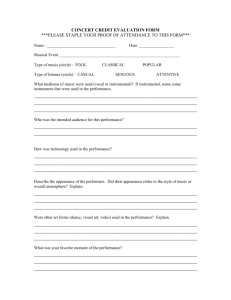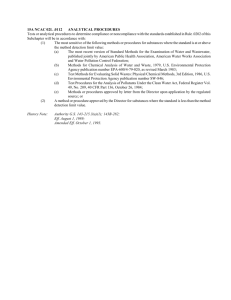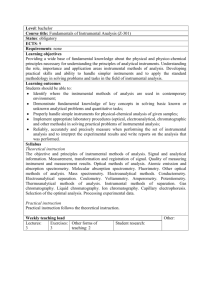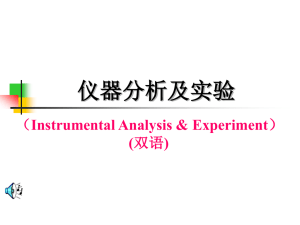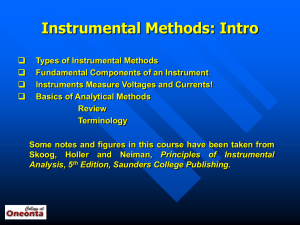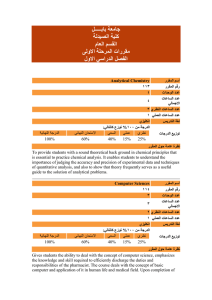File
advertisement
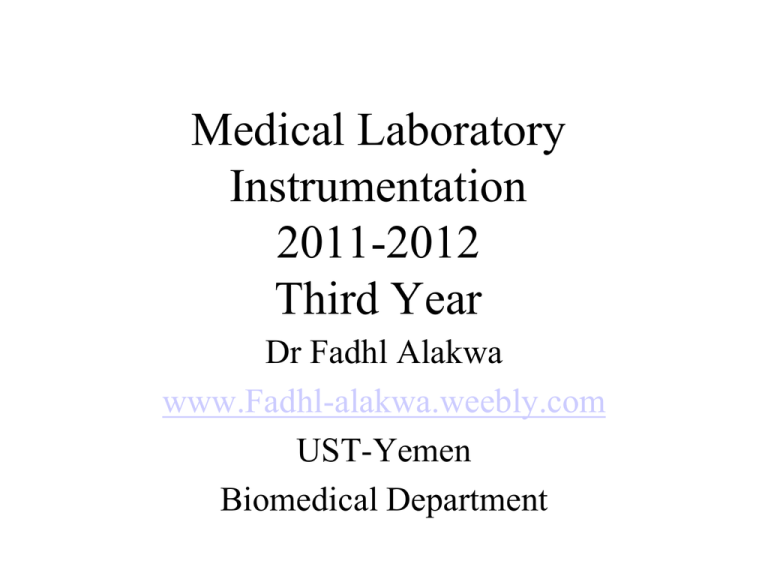
Medical Laboratory Instrumentation 2011-2012 Third Year Dr Fadhl Alakwa www.Fadhl-alakwa.weebly.com UST-Yemen Biomedical Department Course Description: توصيف المقرر • This course provides an introduction to the fundamental principles of chemical measurement used in medical diagnosis, quality assurance and control, and research studies. We will focus on understanding the fundamental principles underlying instrumental methods and their realization in modern instrumentation for analysis. Purpose: الغاية (الهدف) من هذا المقرر • The purpose of this course is to expand the student’s knowledge with new instrumental analysis technology, advantage, disadvantage, troubleshooting and the future technologies. TOPICS COVERED: المواضيع المغطاة • • • • • • • • • UV/visible and infrared spectrophotometry Flame atomic spectrometry Colorimeter Blood gas analyzer Cell counter Pulse Oximeter Chromatograph PCR Electrophoresis STUDENT LEARNING OBJECTIVES أهداف المقرر • FIRST WHAT IS THE PROGRAM OUTCOMES: SEE THE PAPER INFRONT OF YOU. STUDENT LEARNING OBJECTIVES أهداف المقرر 1. Appreciate the connectivity between math, physics, chemistry, and biology in this course. (Program Outcome a). 2. Demonstrate mathematical and basic computer skills, and discover the impact of science and technology. (Program Outcome a, k, h). 3. Understand the proper use and importance of measurement statistics. (Program Outcome b). 4. Understand the theory and design of the instrumental instruments. (Program Outcome c). STUDENT LEARNING OBJECTIVES أهداف المقرر 5. Understand how the instrument actually makes the measurement. (Program Outcome c). 6. Work with his group in any clinical laboratory to complete the project.(Program Outcome d) 7. Uses ethical conduct in communication (using citations, acknowledging sources of info). (Program Outcome f). 8. Conveys information effectively in written and oral presentations. (Program Outcome g). STUDENT LEARNING OBJECTIVES أهداف المقرر 9. Understand and appreciate the role of instruments in solving problems in the physical, chemical and biological sources. (Program Outcome h). 10. Search pertinent, professional literature, use other information resources and evaluate how sources contribute to knowledge. (Program Outcome i) 11.Understand the chemical and/or physical principles exploited during the measurement. (Program Outcome j). 12. Understand the theoretical concepts behind each instrument. (Program Outcome j). STUDENT LEARNING OBJECTIVES أهداف المقرر 13. Operate, manipulate, and generate data for each instrument. (Program Outcome j). 14. Solve chemical problems quantitatively and qualitatively by making appropriate choices among the various instruments. (Program Outcome k). 15. Appreciate the complexity of each instrument, its strength, and its limitation. (Program Outcome k). 16. Explore the use of Internet (Netscape) as an educational source in instrumentation. (Program Outcome k). 17. Develop an understanding of the analytical capabilities of a number of instrumental methods. (Program Outcome k). OUTCOMES COURSE MATRIX [ كيف يمكن للمقرر ]إن يخدم المخرجات األصلية للبرنامج d e f g h k l m BME302 L M H H x M H H M H M x x H : 50% contribution to the outcome. M: 25-50% contribution to the outcome. L: 10-25% contribution to the outcome. Project REPORT Project Exams+ Project Lab Homework Activity to achieve the outcome i j Project + Lab c Project REPORT Project b Project a Project presentation Course/Outco mes COURSE POLICIES • • • • • • سياسة حضور الفصل Class Attendance: حاالت التأخير Tardy: االمتحانات Exams السياسات المتبعة في حاالت الغياب عن االمتحان التكاليف والمشاريع Assignments & Projects: السياسات المتبعة في حاالت تأخير تسليم التكاليف والمشاريع ومتى يجب أن تسلم إلى األستاذ • The PROJECT is due on 01/03/2012. COURSE POLICIES • Exam Attendance/Punctuality: االنتظام وحضور االمتحان • توصيف السياسة المتبعة في حاالت تأخر الطالب عن االمتحان • Plagiarism: االنتحال • يحدد تعريف االنتحال وحاالته واإلجراءات المتبعة في .حالة حدوثه • Plagiarism is defined as “copying or stealing someone else’s words or ideas and claiming or presenting them as if they were your own.” GRADING SYSTEMنظام التقييم • • • • • Term Exam: 60 points Midterm Exam: 15 Points Homework assignments: 5 Points Project: 15 Points Other (quizzes, class participation etc.): 5 points Project • Students will be organized into teams of four and each team search for the principle of operation of instruments which exist in the clinical laboratory. The format of the project is like below: Paramete Disease Instrume Principle Example Distribut r nt of or operation commerciall y In Yemen or KSA Project Evaluation • Oral Presentation Grading: Criteria Points Organization 2 Clarity of presentation 2 Effectiveness 2 Technical Accuracy & grasp of the subject 2 Engineering versus biology content 2 Total 10 RESOURCES: المراجع • Principles of Instrumental Analysis, 5th Edition, Douglas A. Skoog, Brooks Cole, 1998 • Undergraduate Instrumental Analysis, Sixth Edition, James W. Robinson CRC Press, 2004 http://fadhl-alakwa.weebly.com/ Blood (Purpose and components) • Blood is the fluid that circulates trough the heart, arteries, veins and capillaries carrying nourishment, electrolytes, hormones, vitamins, antibodies, heat and oxygen to body tissues and taken a way waste matter and carbon dioxide. • Blood is composed of cells and plasma. Blood cell Portion • Red blood cells • White blood cells • Platelets Red blood cells • • • • • Disc-shaped cells Contain no nucleus Live 120 days Number 4.5 to 5.5 million cells/mm3 Each RBC contains 4 iron atoms in a structure known as the hemoglobin White blood cells • • • • • Amoeba like cells Contain a nucleus Live 20 days Number 6 to 10 thousands cells/mm3 They are present in the lymph fluid and engulf invading bacteria and foreign substances to destroy the invaders’ effect. Platelets • • • • They are cell fragments Contain no nucleus Number 200 to 800 thousands cells/mm3 Blood coagulation and clotting Blood plasma • • • • • Plasma proteins Plasma nutrients-energy-storing Regulatory and protective substances Plasma electrolytes Metabolic waste substances Plasma proteins • Albumins • Fibrinogen and prothrombin • Globulin Plasma nutrients-energy-storing • Glucose (blood sugar) • Lipids (fats) • Amino acids (Proteins for tissue growth) Regulatory and protective substances • Enzymes • Hormones • Antibodies Plasma electrolytes-acid-base • Na+ • K+ • Cl- Metabolic waste substances • Urea • Uric http://en.wikipedia.org/wiki/Reference_ranges_for_common_blood_tests Purpose of M. L. I. The purpose of medical laboratory instrumentation is to provide a means of measuring required substances and metabolic waste products in urine and blood. Instrumental Analysis is the Base for All the Modern Sciences Instrumental Analysis will give quick answers on (1) what species is a certain system (qualitative) and (2) How many of them (quantitative). Analytical chemistry is critical to our understanding of biochemistry, medicinal chemistry, geochemistry, environmental science, atmospheric chemistry, materials science, metallurgy, biology, pharmacology, agricultural science, food science, geology, and other fields. Qualitative analysis • Qualitative analysis is the branch of analytical chemistry that is concerned with questions • such as “What makes this water smell bad?”, “Is there gold in this rock sample?”, “Is this sparkling stone a diamond or cubic zirconia?”, “Is this plastic item made of polyvinyl chloride, polyethylene or polycarbonate?”, or “What is this white powder?” Quantitative Analysis • When qualitative analysis is completed, the next question is often “How much of each or any component is present?” or “Exactly how much gold is this rock?” or “How much of the organochlorine pesticide dieldrin is in this drinking water?” • The determination of how much is quantitative analysis. undergraduate instrumental analysis page 9,10,11,12 Basics of Instrumental Analysis Stimulus Energy Source Input transducer Response Analytical Information Sample Data domain of Transduced information Information processor Readout Basics of Instrumental Analysis • All instruments measure some chemical or physical characteristic of the sample, such as how much light is absorbed by the sample at a given wavelength, the mass-to charge ratio of an ion produced from the sample, or the change in conductivity of a wire as the sample passes over it. A detector of some type makes the measurement and the detector response is converted to an electrical signal. The electrical signal should be directly related to the chemical or physical property being measured and that should be related to the amount of analyte present. Selecting Analytical Instruments In order to select an analytical method intelligently, it is essential to define clearly the nature of the analytical problem. Such a definition requires answers to the following questions: 1. What accuracy is required? 2. How much sample is available? 3. What is the concentration range of the analyte? 4. What components of the sample will cause interference? 5. What are the physical and chemical properties of the sample matrix? 6. How many samples are to be analyzed? Precision and Accuracy Not precise Not accurate Not precise But accurate Precise And accurate Precise But not accurate Concentration Unit • Many analytical results are expressed as the concentration of the measured substance in a certain amount of sample. The measured substance is called the analyte. • Commonly used concentration units include molarity (moles of substance per liter of solution), weight percent (grams of substance per gram of sample 100%), and units for trace levels of substances. • One part per million (ppm) by weight is one microgram of analyte in a gram of sample, that is, 1 x 10-6 g analyte/g sample. µg/g • One part per billion (ppb) by weight is one nanogram of element in a gram of sample or 1 x 10-9 g analyte/g sample. • parts per trillion of the element, that is, picograms of element per gram of sample (1 x10-12 g analyte/g sample). Concentration Unit? • To give you a feeling for these quantities, a million seconds is 12 days (11.57 days, to be exact). One part per million in units of seconds would be one second in 12 days. • A part per billion in units of seconds would be 1 s in 32 years, and one part per trillion is one second in 32,000 years. Terminology • A sample may be homogeneous, that is, it has the same chemical composition everywhere within the sample. Like the salt water. • Many samples are heterogeneous; the composition varies from region to region within the sample. Medical laboratory department • Facilities • Personnel • Equipment Facilities • Must includes a clean, safe surrounding with a special area for sterilization of contaminated blood urine samples and equipment • Sufficient storage and cleaning areas must be designated Personnel • Physician • Medical technologist (equipment operator) • Supervisor Equipment • Glassware, centrifuges, suction devices • Colorimeter Is an optical devise that measures the color concentration of a substance in solution • Flame photometer Is an optical electronic devise that measures the color intensity of substance that have been aspirated into a flame (sodium and potassium) Equipment • Spectrophotometer Is optical device that measure light absorption at various wavelengths for a given liquid sample. • Blood cell analyzer Is a device to measures the number of red and white blood cells per scaled volume. The aperture impedance and flow cytometery Equipment • Ph/ blood gas analyzer Is a device which measure blood Ph, Po2, Pco2 • Chromatograph and Autoanalyzer Is a electromechanical device used to separate, identify, and measure the concentration of substances in a liquid medium. • Computer based record and operation system
